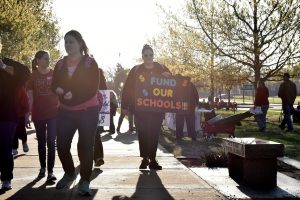
By Heide Brandes and Lenzy Krehbiel-Burton
OKLAHOMA CITY/TULSA, Okla. (Reuters) – High school physics teacher Craig Hoxie filed to run for Oklahoma’s House of Representatives on Friday, a day after the end of a two-week teacher walkout that had pressed lawmakers for school funding.
“A week ago, I would have told you I wasn’t going to do it,” said the 48-year-old Army veteran who has worked in public schools for 18 years, as he drove to the state election board office to submit his paperwork to become a Democratic candidate in this fall’s election. “There is a funding crisis with all public services in our state.”
Teachers and parents in Oklahoma, West Virginia, Kentucky and Arizona have staged collective actions in recent weeks, seeking higher wages and education spending. They say years of budget reductions have decimated public school systems in favor of tax cuts.
Protests in those Republican-dominated states have encouraged teachers unions and Democratic candidates who will try to capitalize on the outrage to score electoral victories. In November’s mid-term elections, 36 governorships and thousands of state legislative seats will be up for grabs.
“This transcends what has traditionally been viewed as blue states and red states,” said Randi Weingarten, president of the American Federation of Teachers, which boasts 1.7 million members. “The deprivation has gotten so great that people are taking the risk to escalate their activism.”
The union, typically aligned with the Democratic Party, has targeted a number of key states with plans to mobilize in statehouse, gubernatorial and congressional elections this fall.
Nationwide, progressive causes have seen a surge of enthusiasm since Republican President Donald Trump’s election. Protesters have rallied on issues as wide ranging as gun control, gender equality, science and immigrants’ rights.
The Oklahoma walkout demonstrated the power of collective action to influence Republican lawmakers, as well as its limits. The legislature boosted annual education funding by about $450 million and raised teacher pay by an average of about $6,100, yet those figures remained short of the teachers’ demands.
The state’s largest union, the Oklahoma Education Association (OEA), declared victory and turned its attention to the fall elections to continue the fight for more funding. At least a dozen Oklahoma teachers are seeking office.
In remarks to the Tulsa County Democratic Party on Friday, OEA President Alicia Priest said local union chapters would form election committees to support pro-education candidates, while members will go door-to-door.
“We have to change and try something different,” she said of teachers choosing to run for office themselves.
Several Republican incumbents facing challenges from teacher candidates did not respond to calls for comment.
Sheri Guyse, 42, a parent with two children in Oklahoma public schools who participated in the walkout, pledged that come November, she would remember whose side lawmakers were on.
“A few of their demands were met, and of course that’s a step in the right direction, but the only thing I’m feeling really good about today is that there’s a big election in November where a lot of these legislators will lose their jobs,” she said.
A number of teachers have already won special legislative elections as Democrats in the last two years. Karen Gaddis, a retired teacher who ran on a largely pro-education platform, captured a seat near Tulsa that had been in Republican hands for more than 20 years.
“Things have gotten so bad out here, we’re like a third-world country,”” Gaddis said in a phone interview. She first ran and lost in 2016, but said she has sensed a shift this year as people have grown fed up with budget cuts.
“Education in particular was just being flushed down the toilet,” she said.
The Democratic Legislative Campaign Committee, which focuses on statehouse races nationwide, said more than 50 educators are running in other states. The group said the 26 states in which Republicans control both the legislature and the governorship have seen an average 5 percent cut in education spending over the last decade.
In response, David James, a spokesman for the Republican State Leadership Committee, which supports that party in statehouse races, said, “It is sad and appalling for the Democrats to be coordinating a national protest effort with their longtime faculty room friends in the teachers unions to push a political agenda in the classroom, at the expense of the nation’s students.”
John Waldron, a social studies teacher, ran unsuccessfully for state Senate in Oklahoma in 2016. He is running again as a Democrat in 2018, this time for the state House of Representatives, and said the walkout gives him confidence this campaign will unfold differently.
“We’ve turned a whole generation of Oklahomans into political activists now,” he said.
(Reporting by Heide Brandes in Oklahoma City and Lenzy Krehbiel-Burton in Tulsa; Writing and additional reporting by Joseph Ax in New York; Editing by Colleen Jenkins and David Gregorio)









